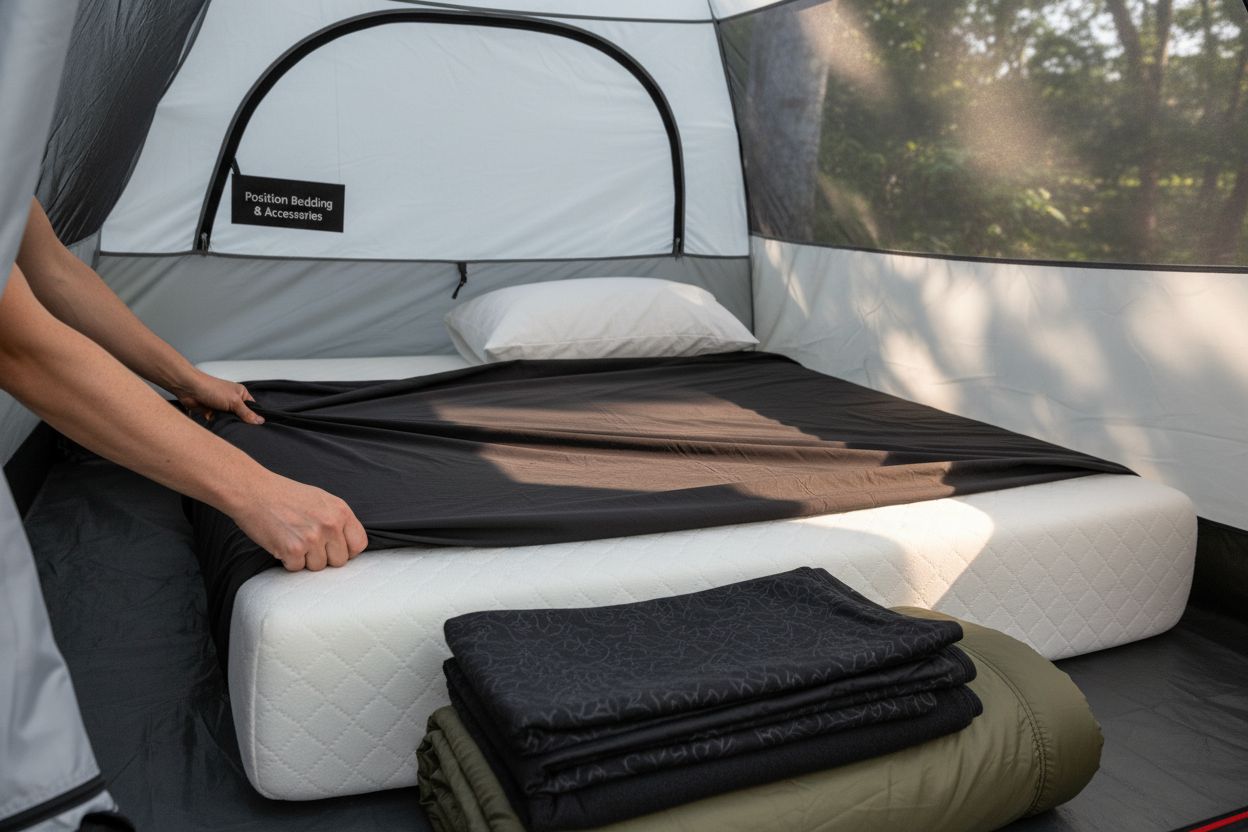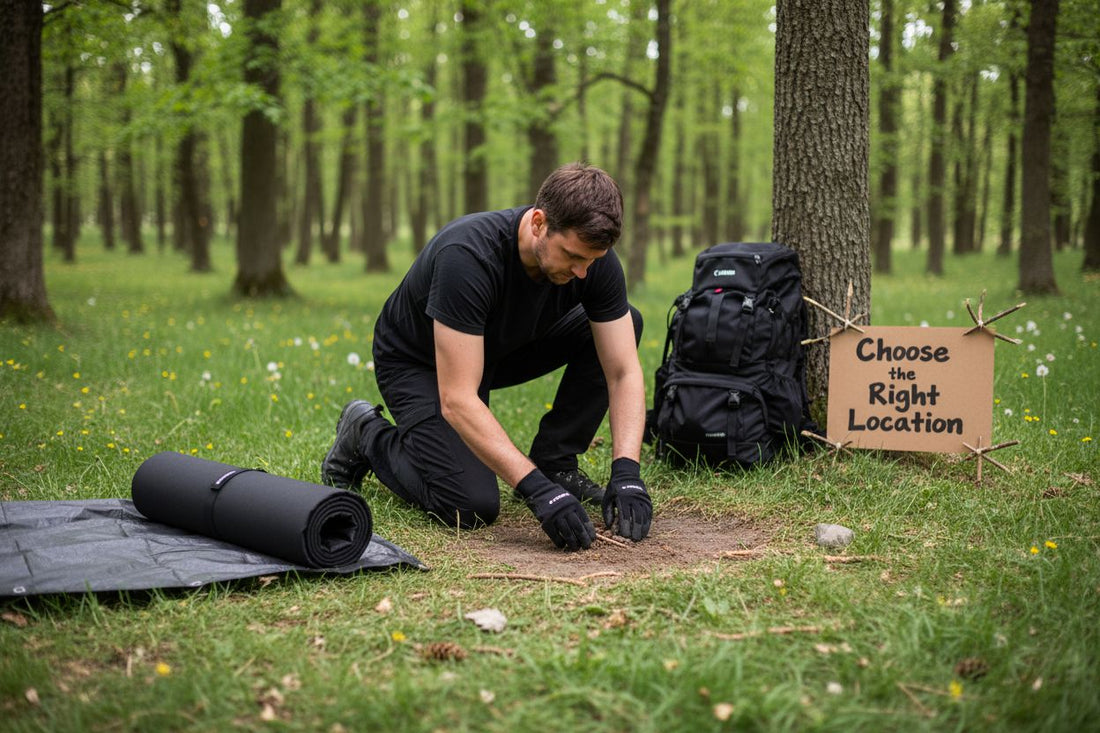Setting up a memory foam mattress outdoors sounds simple enough and many campers think it is just about unrolling and relaxing. Think again. A top-quality memory foam mattress can lose up to 30 percent of its support if placed on uneven or rocky ground and you only discover it after a night of tossing and turning. The real secret is that your entire outdoor sleep quality depends less on the mattress itself and more on where and how you set it up from the start.
Table of Contents
- Step 1: Choose The Right Location For Setup
- Step 2: Unbox And Unroll The Mattress Properly
- Step 3: Allow The Mattress To Expand Fully
- Step 4: Position Your Bedding And Accessories
- Step 5: Test The Mattress For Comfort And Support
Quick Summary
| Key Point | Explanation |
|---|---|
| 1. Choose a Flat, Level Surface | Select a stable, flat area for your mattress to ensure optimal comfort and support during your sleep. |
| 2. Allow Time for Mattress Expansion | Unroll the mattress and give it time to expand fully, which may take several hours to 48 hours for optimal comfort. |
| 3. Use Proper Bedding Layers | Utilize moisture-wicking sheets and appropriate sleeping bags to enhance temperature regulation and comfort throughout the night. |
| 4. Test for Comfort and Support | Assess the mattress by lying in different positions to ensure it provides adequate support and meets your comfort needs. |
| 5. Protect Your Mattress | Employ a lightweight mattress protector to shield against moisture and dirt, extending the lifespan of your memory foam mattress. |
Step 1: Choose the Right Location for Setup
Selecting the optimal location for your memory foam mattress setup is crucial for ensuring outdoor comfort and maximizing your camping experience. The right spot can transform a potentially challenging sleeping environment into a restful retreat.
Begin by surveying your outdoor terrain with a critical eye. Look for a flat, level surface that provides stability for your memory foam mattress. Rocky, uneven ground can compromise the mattress performance and your overall sleeping comfort. Ideally, you want a space that minimizes ground contact points which could potentially damage the mattress or create uncomfortable pressure zones.
Ground preparation becomes essential in this initial setup phase. Clear the area of sticks, rocks, pinecones, and other debris that might puncture or create uneven surfaces. A smooth ground surface ensures your memory foam mattress maintains its structural integrity and provides consistent support. Consider using a ground cloth or protective barrier underneath the mattress as an additional protective measure. This extra layer helps prevent moisture absorption and shields the mattress from potential sharp objects or rough terrain.
When evaluating potential locations, consider environmental factors beyond just the ground surface. Seek areas with natural wind protection like tree lines or rock formations that can buffer against strong gusts. Avoid low-lying areas prone to water accumulation during unexpected rain or morning dew. Slightly elevated ground with good drainage will help keep your sleeping area dry and comfortable.
Temperature regulation is another critical consideration when choosing your setup location. Aim for spots that offer a balance between sun exposure and shade. Direct sunlight can cause memory foam to heat up excessively, while complete shade might make the area too cool. Look for locations that provide partial sunlight during the day and natural shade during peak heat hours.
Remember that your memory foam mattress setup is about creating a personal comfort zone in the wilderness. Take your time surveying the area, test the ground stability, and trust your instincts about what feels like a good sleeping environment. A thoughtful location selection sets the foundation for a restful outdoor experience that combines the comfort of home with the adventure of nature.
This checklist table provides a concise overview of key verification points for each step of the outdoor memory foam mattress setup process, helping ensure a comfortable and successful experience.
| Setup Step | Key Checklist Item | Purpose/Outcome |
|---|---|---|
| Choose Location | Ground is flat, clear, and well-drained | Prevents discomfort and damage |
| Unbox/Unroll Mattress | No tears; mattress expands evenly | Ensures mattress longevity and comfort |
| Allow to Expand | Fully expanded; no indentations | Achieves optimal shape and support |
| Position Bedding | Sheets are secure; protector in place | Enhances comfort and protection |
| Test for Comfort | Supportive with no pressure points | Confirms readiness for sleep |
Quick Verification Checklist:
- Surface is relatively flat and level
- Area is clear of sharp objects and debris
- Ground has natural wind protection
- Location offers balanced sun and shade exposure
- Surface provides good drainage
Step 2: Unbox and Unroll the Mattress Properly
Unboxing and unrolling your memory foam mattress requires careful attention to ensure optimal performance and longevity. This critical step sets the foundation for a comfortable outdoor sleeping experience. Proper handling during this phase can significantly impact the mattress’s comfort and durability.
Begin by carefully removing the mattress from its packaging, taking care not to use sharp objects that might accidentally puncture the material. Memory foam mattresses are typically compressed and rolled tightly for shipping, so patience is key during the unrolling process. Gently remove any protective packaging, ensuring you do not accidentally tear the mattress cover or damage the foam material.
Position the rolled mattress in your prepared location, oriented exactly how you want it to be situated. Slowly unroll the mattress, allowing it to expand naturally without forcing or stretching the material. The expansion process can take several hours, so give yourself ample time before expecting full comfort.
 Some memory foam mattresses might require up to 24 to 48 hours to reach complete expansion, though most will be reasonably comfortable within a few hours. Check out our guide on camp bedding organization for additional tips on managing your outdoor sleeping setup.
Some memory foam mattresses might require up to 24 to 48 hours to reach complete expansion, though most will be reasonably comfortable within a few hours. Check out our guide on camp bedding organization for additional tips on managing your outdoor sleeping setup.
As the mattress unfurls, gently smooth out any potential wrinkles or creases in the cover. Avoid pulling or tugging aggressively, which could damage the delicate foam structure. If you notice any uneven areas or spots that seem slower to expand, give the mattress time and allow natural air circulation to help the process. Light, gentle movements can help encourage even expansion, but excessive manipulation might compromise the mattress’s integrity.
Environmental factors play a crucial role in the mattress expansion process. Warmer temperatures typically facilitate faster and more even expansion, while very cold conditions might slow down the process. If possible, choose a location with moderate temperature and good air circulation. Avoid direct sunlight, which can cause uneven heating and potentially damage the memory foam material.
Quick Verification Checklist:
- Mattress is completely unrolled
- No visible tears or damage to mattress cover
- Mattress appears to be expanding evenly
- Surface feels smooth with minimal wrinkles
- Mattress is positioned correctly in the desired location
Step 3: Allow the Mattress to Expand Fully
Allowing your memory foam mattress to expand fully is a critical step that directly impacts your comfort and the mattress’s long-term performance. This phase requires patience and careful attention to ensure the mattress reaches its optimal shape and support capabilities.
The expansion process is more than just waiting it is about creating the right environment for your memory foam to recover its intended structure. After unrolling, memory foam mattresses need time to regain their original form, which can vary depending on environmental conditions and the specific mattress design. Typically, most memory foam mattresses will reach about 90% of their full expansion within 4 to 6 hours, but complete recovery can take up to 24 to 48 hours.
Temperature plays a significant role in the expansion process. Memory foam is temperature-sensitive, meaning it responds to ambient conditions. Cooler environments will slow down expansion, while moderate temperatures between 60 to 72 degrees Fahrenheit provide the ideal setting for optimal recovery. If you are camping in cooler conditions, consider using a lightweight blanket or tarp to create a slightly warmer microclimate around the mattress without directly touching it. Learn more about maintaining your camping mattress with our comprehensive cleaning guide to ensure long-lasting performance.
Avoid the temptation to accelerate the expansion process through artificial means. Do not use heat sources like portable heaters or direct sunlight, as these can cause uneven expansion or potentially damage the foam’s cellular structure. Instead, allow natural air circulation to help the mattress gradually return to its intended shape. If you notice any areas that seem slower to expand, gently massage the surface with your hands to encourage even recovery.
Proper positioning is crucial during this phase. Ensure the mattress is laid out completely flat without any objects on top of it that might impede expansion. Keep pets and heavy items away from the mattress during this critical period. Some campers make the mistake of placing sleeping bags or additional gear on the mattress before it has fully expanded, which can create permanent indentations or compromise the foam’s supportive qualities.
Quick Verification Checklist:
- Mattress appears fully expanded and smooth
- No visible indentations or uneven areas
- Surface feels consistent and supportive
- Mattress maintains its original shape
- No signs of permanent compression or damage
Step 4: Position Your Bedding and Accessories
Positioning your bedding and accessories is more than just throwing down a sleeping bag. This critical step transforms your memory foam mattress from a bare surface into a comfortable sleeping sanctuary that protects and enhances your outdoor rest. Proper layering and strategic placement can dramatically improve your sleeping experience.
Start by selecting bedding specifically designed for outdoor environments. Lightweight, moisture-wicking sheets work best with memory foam mattresses, as they allow better temperature regulation and prevent unnecessary heat buildup. Consider using fitted sheets designed for camping mattresses that will stay securely in place, preventing bunching or shifting during the night. Elastic-edged sheets are particularly effective for maintaining a smooth, consistent surface.
Temperature management becomes crucial when selecting your sleeping layers. Choose sleeping bags or blankets that complement the memory foam mattress’s thermal properties. Synthetic or down-filled options that offer temperature adaptability work best in variable outdoor conditions. Layer your bedding strategically, starting with a thin thermal base layer directly on the mattress, followed by your primary sleeping bag or blanket. This approach allows for easy temperature adjustment during nighttime temperature fluctuations.

Accessory placement requires thoughtful consideration. Position pillows that provide proper neck and head support, taking into account the memory foam mattress’s contouring properties. If you are using multiple pillows, arrange them to create a supportive sleeping environment that maintains natural spine alignment. Consider bringing compact, compressible camping pillows that offer both comfort and easy transportation.
Protective layers are not just about comfort but also about mattress preservation. Use a lightweight mattress protector that shields against moisture, dirt, and potential punctures. These protective covers can significantly extend your memory foam mattress’s lifespan, especially in unpredictable outdoor environments. Our comprehensive camp mattress cleaning guide offers additional insights into maintaining your outdoor sleeping gear.
Remember that personal comfort varies, so be prepared to make minor adjustments throughout your trip. The beauty of a memory foam mattress is its ability to adapt to your body, but your bedding setup can enhance or diminish this natural comfort.
Quick Verification Checklist:
- Sheets are smooth and securely fitted
- Sleeping bag/blankets are strategically layered
- Pillows provide proper support
- Mattress protector is in place
- Bedding allows for easy temperature regulation
Step 5: Test the Mattress for Comfort and Support
Testing your memory foam mattress for comfort and support is the crucial final step that determines whether your outdoor sleeping setup will provide the restorative rest you need. This evaluation goes beyond simple first impressions and requires a systematic approach to understanding how the mattress responds to your body and sleeping style.
Initial comfort testing involves more than just lying down it requires intentional movement and positioning. Start by sitting on different areas of the mattress to assess its surface consistency and responsiveness. Press your hand into various sections, observing how quickly the memory foam recovers its shape. A high-quality memory foam mattress should smoothly contour to your body while maintaining supportive resistance.
Test multiple sleeping positions to understand the mattress’s performance. Begin on your back, paying attention to how the foam supports your spine’s natural alignment. Notice whether there are pressure points around your shoulders, lower back, or hips. Next, shift to your side and evaluate how the mattress accommodates your body’s curves. Memory foam should create a gentle cradle that distributes weight evenly, reducing potential discomfort during extended periods of rest.
Temperature and body weight play significant roles in memory foam performance. If possible, have multiple people test the mattress to understand its adaptability. Lighter individuals might experience different support characteristics compared to those with more body weight. Pay special attention to how the mattress responds to your unique body composition. Our comprehensive camp bedding organization guide offers additional insights into maximizing outdoor sleeping comfort.
Environmental factors can influence mattress performance, so simulate potential camping conditions during your testing. If you anticipate sleeping in cooler temperatures, briefly expose the mattress to similar conditions to understand how its foam might stiffen or respond. Memory foam can become slightly firmer in colder environments, which might affect its comfort and support characteristics.
Listen to your body during the testing phase. Comfort is subjective, and what works for one person might not work perfectly for another. Take your time with this evaluation, spending at least 10 to 15 minutes in different positions.
Below is a troubleshooting table summarizing common issues with outdoor memory foam mattress setup, possible causes, and recommended solutions based on scenarios described in the article.
| Issue | Possible Cause | Suggested Solution |
|---|---|---|
| Mattress feels uneven or unsupportive | Set up on rocky or uneven ground | Relocate to a flat, level surface and clear debris |
| Mattress expands slowly | Cold temperatures or poor air circulation | Choose a moderate temperature area with good air flow; be patient and allow extra time |
| Wrinkles or creases in mattress surface | Mattress not fully unrolled or packaging removed too quickly | Gently smooth the surface and allow more time for expansion |
| Mattress gets too warm | Placed in direct sunlight or lacks moisture-wicking bedding | Use bedding with temperature regulation and select a shaded or partially shaded spot |
| Retains moisture or gets damp | No protector or set up in low-lying area | Use a mattress protector and choose a location with good drainage |
| Indentations or loss of shape | Place heavy items or sleep on it before full expansion | Wait until mattress is fully expanded before use and keep it clear of heavy objects during setup |
| Minor adjustments to bedding, pillow placement, or even mattress orientation can significantly enhance your overall sleeping experience. |
Quick Verification Checklist:
- Mattress provides consistent support across different areas
- No significant pressure points detected
- Spine remains aligned in multiple sleeping positions
- Foam quickly recovers its original shape
- Overall comfort meets personal expectations
Transform Your Outdoor Sleep With Hazli Collection
Tired of waking up sore after a night on uneven ground or struggling to set up your mattress for true outdoor comfort? The article highlighted how finding a level spot, careful unrolling, and strategic layering are crucial for outdoor mattress success. Yet, even when you follow each step, low-quality gear can stand in the way of comfortable sleep. Why risk restless nights when you can choose reliable memory foam solutions designed for real-world adventure?

Upgrade your camping gear now and enjoy the benefits of easy setup, superior support, and restful nights under the stars. Explore the wide range of high-quality outdoor mattresses and accessories at Hazli Collection. Discover solutions trusted by nature lovers and adventure seekers nationwide. Do not wait for your next outdoor trip to become another uncomfortable story. Shop today and experience the Hazli difference firsthand.
Frequently Asked Questions
How do I choose the right location for setting up my memory foam mattress while camping?
It’s essential to select a flat, level surface that minimizes ground contact points and provides stability. Clear the area of sharp objects and consider environmental factors like wind protection and drainage to ensure comfort.
What should I do during the unboxing and unrolling of my memory foam mattress?
Carefully remove the mattress from its packaging without using sharp objects that might damage it. Slowly unroll the mattress in your chosen location, allowing it to expand naturally for optimal comfort.
How long does it take for a memory foam mattress to fully expand when set up outdoors?
Most memory foam mattresses will reach about 90% of their full expansion within 4 to 6 hours, but complete recovery can take up to 24 to 48 hours, depending on environmental conditions.
What bedding and accessories are best for a memory foam mattress when camping?
Choose lightweight, moisture-wicking sheets and temperature-adaptive sleeping bags or blankets. Use a mattress protector to shield against moisture and debris, and ensure your pillows provide proper support to enhance your comfort.

